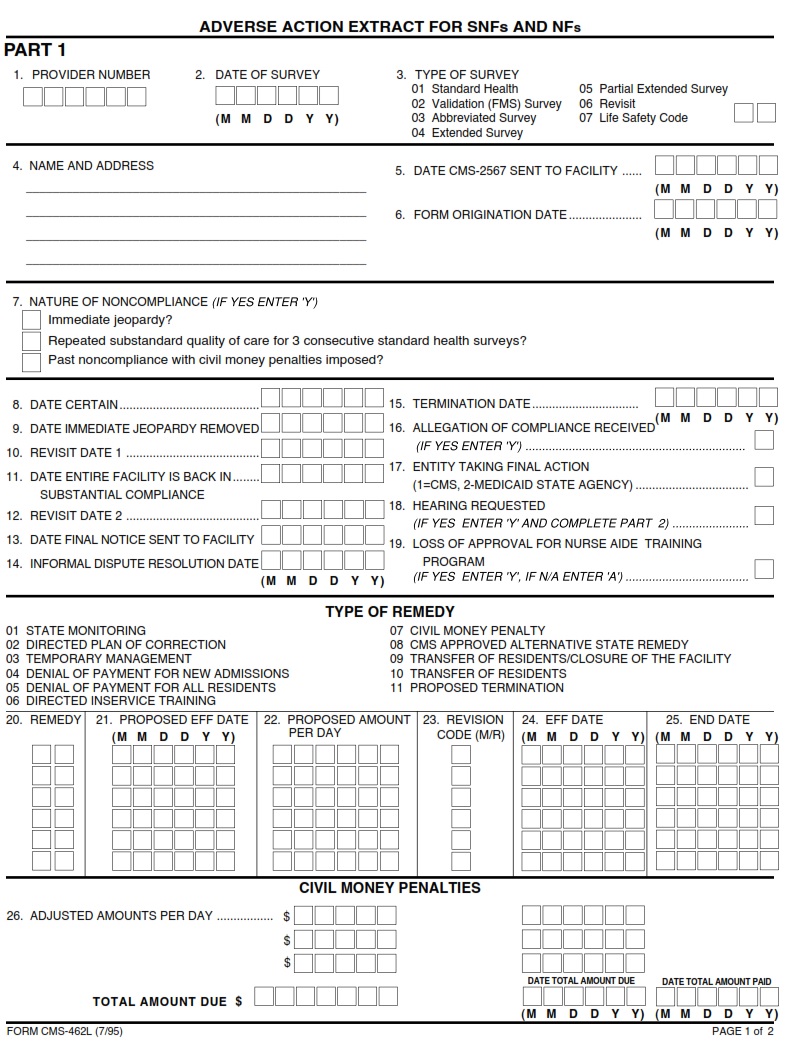CMSFORM.ORG – CMS 462L – ADVERSE ACTI0N EXTRACT FOR SNFs AND NFs – In the fast-paced world of healthcare compliance, navigating the intricate regulations governing skilled nursing facilities (SNFs) and nursing homes (NFs) can be a daunting task. One such regulation that often proves to be a challenging terrain for providers is the CMS 462L – Adverse Action Extract. This extract serves as a crucial tool in identifying patterns of non-compliance and potential risks within SNFs and NFs, making it an indispensable component in ensuring quality care for vulnerable residents.
As we delve deeper into the realm of adverse actions within long-term care settings, it becomes evident that the implications of this extract extend far beyond mere regulatory checkboxes. From safeguarding patient welfare to upholding standards of excellence, understanding the nuances of CMS 462L is essential for administrators, healthcare professionals, and policymakers alike. Join us on an exploratory journey as we unravel the complexities surrounding adverse actions in SNFs and NFs, shedding light on how adherence to these guidelines can ultimately elevate the standard of care provided to our elderly population.
Download CMS 462L – ADVERSE ACTI0N EXTRACT FOR SNFs AND NFs
| Form Number | CMS 462L |
| Form Title | ADVERSE ACTI0N EXTRACT FOR SNFs AND NFs |
| Published | 1995-07-01 |
| O.M.B. | – |
| File Size | 108 KB |
CMS 462L - ADVERSE ACTI0N EXTRACT FOR SNFs AND NFs (704 downloads )
What is a CMS 462L?
CMS 462L, as an Adverse Action Extract for SNFs and NFs, plays a crucial role in monitoring the quality of care provided by skilled nursing facilities (SNFs) and nursing homes. This form serves as a tool for the Centers for Medicare & Medicaid Services (CMS) to track any adverse actions taken against these facilities, such as citations, fines, or other enforcement actions. By collecting this data, CMS can identify trends and patterns that may indicate areas of concern within these healthcare settings.
Furthermore, CMS 462L helps to promote transparency and accountability within the healthcare industry by making information about adverse actions accessible to the public. This allows consumers and stakeholders to make informed decisions when choosing a SNF or NF for themselves or their loved ones. The availability of this data also encourages facilities to maintain high standards of care and compliance with regulations in order to avoid negative repercussions from CMS.
Where Can I Find a CMS 462L?
When searching for a CMS 462L form, it is essential to know where to look. One of the primary sources for obtaining this form is through the Centers for Medicare and Medicaid Services (CMS) website. Here, you can access various forms related to adverse actions in skilled nursing facilities (SNFs) and nursing homes (NFs). Additionally, healthcare organizations and regulatory agencies may also provide access to the CMS 462L form.
Another avenue to explore is contacting your state’s Department of Health or Aging services. They often have resources available or can direct you on where to find the required documentation. Moreover, consulting with legal or compliance professionals in the healthcare industry may lead you in the right direction when seeking out the CMS 462L form. Remember that staying informed about regulations and proper procedures regarding adverse actions in SNFs and NFs is crucial for maintaining compliance and ensuring quality care for residents.
CMS 462L – ADVERSE ACTI0N EXTRACT FOR SNFs AND NFs
CMS 462L – Adverse Action Extract for SNFs and NFs serves as a crucial tool in maintaining quality standards within healthcare facilities. This extract captures essential data related to adverse actions taken against Skilled Nursing Facilities (SNFs) and Nursing Facilities (NFs), shedding light on areas that require improvement or intervention. By analyzing this information, regulatory bodies can identify trends, patterns, and outliers that may indicate underlying issues affecting patient care.
One significant advantage of using CMS 462L is its ability to highlight potential risks and ensure accountability within SNFs and NFs. By providing a comprehensive overview of adverse events such as deficiencies in care, violations of regulations, or safety concerns, this extract empowers stakeholders to take proactive measures in addressing gaps in quality assurance. Moreover, the transparency offered by CMS 462L fosters a culture of continuous improvement by encouraging facilities to learn from past mistakes and implement sustainable changes to enhance patient outcomes.
In conclusion, the utilization of CMS 462L as an adverse action extract underscores the importance of promoting accountability and upholding standards of care within healthcare settings. As part of regulatory oversight efforts, this tool not only enables authorities to monitor compliance but also encourages a collaborative approach towards achieving excellence in patient-centered services across SNFs and NFs. Embracing the insights gleaned from CMS 462L can drive positive transformations that safeguard the well-being of residents and uphold the reputation of long-term care facilities within the broader healthcare landscape.

